| European Tour Report - July 1-7, 2010 | | | |
| Tuesday, 03 August 2010 |
| Tridandisvami Sri Srimad Bhaktivedanta Narayana Gosvami Maharaja 2010 European Vaisnava Festival Marina di Massa, Italy: July 1-7, 2010
The festival was held in the west-coast town of Marina di Massa, Italy, between the Marble Mountains and the Mediterranean Sea. Over twenty-five countries were represented, from every continent but Antarctica, including Russia, Poland, Brazil, Argentina, Costa Rica, Australia, New Zealand, Jamaica, Canada, Iran, Mexico, and South and West Africa. 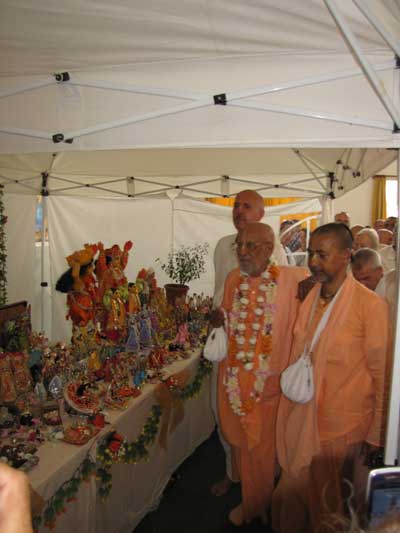 Greeting the Deities 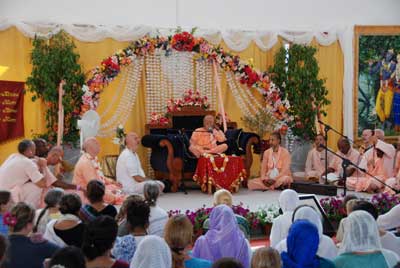 Evening class Srila Narayana Gosvami Maharaja chose to speak on the topic of Srimad-Bhagavatam, every day covering some of the most essential pastimes from each Canto, from the First to the Tenth. The first day began with the subject of bhakti with the goal of practicing twenty-four hours a day, seven days a week. In that connection, Srila Maharaja discussed the conversation between the sages in Naimisaranya and Sri Suta Gosvami, in which the sages asked Suta Gosvami how their souls can be happy: "After Krsna concluded His pastimes in this world 5,000 years ago, Kali-yuga, the age of quarrel and hypocrisy, arrived. At that time eighty-eight thousand rsis and maharsis gathered in Naimisaranya, and there they were thinking about what should be done to protect the world from the influence of the imminent Kali-yuga. Ladies and men would give up their chastity. So many ladies would be like prostitutes, and men will give up their religions. The sages contemplated, "What should we do?" "In the mean time, Sri Suta Gosvami, the disciple of Srila Sukadeva Gosvami arrived on the scene, and the sages asked him what to do, just as Pariksit Maharaja had inquired from Sukadeva Gosvami, 'For those who know that they will die within a few days, and for those who don't know when they will die – for those who will die today, or tomorrow or the day after, and for those who will die after a hundred or a hundred and twenty-five years – we must all die. What, then, is our duty?' prayenalpayusah sabhya ["O learned one, in this iron age of Kali men have but short lives. They are quarrelsome, lazy, misguided, unlucky and, above all, always disturbed." (Srimad-Bhagavatam 1.1.10)] "'Kali-yuga is here, and everyone's lifespan is very short. In Satya-yuga, the age of goodness, people's lifespan was one-hundred-thousand years. In Satya-yuga, Bharat Maharaja renounced the world at the age of fifty, meaning fifty-thousand. So, people's age in Kali-yuga is very short. And manda-bhagya – their luck is not good; they are unlucky. You know all this from your Gurudeva; so please enlighten us, by your realized experience and from what you have heard from your Gurudeva. Please tell us how the atma (soul) will be fortunate.'" "The sages did not ask, 'How will our body be happy.' Rather, they asked, 'How will our atma be happy?'" "Hearing this question, Srila Suta Gosvami offered his pranama to his Gurudeva and said, "I'm very happy to hear this question, and all the sweet pastimes of Krsna will come in the answer." sa vai pumsam paro dharmo "Srila Suta Gosvami explained, 'That bhakti which is unbroken, which is performed only for pleasing Krsna, and which is without any material motive can truly satisfy the self.' In order to reveal the true answer to this question for the benefit of all beings, Srila Rupa Gosvami has written a most powerful verse by the mercy of Sri Caitanya Maharaprabhu:" anyabhilasita sunyam ["The cultivation of activities that are meant exclusively for the pleasure of Sri Krsna, or in other words the uninterrupted flow of service to Sri Krsna, performed through all endeavours of the body, mind and speech, and through the expression of various spiritual sentiments (bhavas), which is not covered by jnana (knowledge aimed at impersonal liberation) and karma (reward-seeking activity), and which is devoid of all desires other than the aspiration to bring happiness to Sri Krsna, is called uttama-bhakti, pure devotional service." (Sri Bhakti-rasamrta-sindhu 1.1.11)] Srila Maharaja explained that this type of bhakti leads to pure knowledge and detachment: vasudeve bhagavati ["By rendering devotional service unto the Personality of Godhead, Sri Krsna, one immediately acquires causeless knowledge and detachment from the world." (Srimad-Bhagavatam, 1.2.7)] He told his audience, "If anyone performs this kind of bhakti, then vairagya (renunciation) will come to him at once. It is bound to come; and jnana (transcendental knowledge) will also come. That person will have knowledge of all tattvas (established philosophical truths), such as maya-tattva, krsna-tattva, jiva-tattva, etc. It is absurd to think that if one is actually performing bhakti, jnana and vairagya will not also be present. If they are not present, this means that it is something other than bhakti that is being performed. If one is a grhasta (householder), by his performance of bhakti he will give up all his attachments, as Bharata Maharaja did. That grhastha will go to the jungle to avail himself of sadhu-sanga and practice bhakti-yoga.
The following day focused on the glories of the Supreme Lord's name, with the example of Ajamila, who, although had fallen to the depths of depravity and corruption by the degrading association of a prostitute, became enlightened and delivered by the holy name and holy association of the associates of the Lord. Srila Maharaja also illumined his international audience with the history of Bharata Maharaja, a saintly king who, after renouncing his kingdom and entering the forest for a life of bhajana, became attached to a deer. In his next life he took birth as a deer – all the while, by God's mercy able to remember his former life – and so in his third life he became the self-realized soul, Jada Bharata. The lesson learned: "don't be attached to material things or personalities, and don't be slack with your devotional practices." On the second day of the festival, as he was accustomed to do at every festival, Srila Maharaja declared that all of the books that were brought to the festival should be gone in two days. He announced, "Preaching depends on books. Srila Bhaktivedanta Svami Maharaja, my siksa-guru, sent his books to the mountains and in the midst of oceans – everywhere. Wherever he could not personally reach, his books went there. And, reading his books, so many new devotees joined. In a very few months he established mathas (temples) everywhere in the world. "I have given as many books as he gave; I have published one hundred or more books. Why not distribute my books? I request all of you: thinking book distribution as one of the most important preaching means, please very freely arrange that my books reach everywhere, as did his books. In one or two days, I no longer want to see any books in my book stalls. Top to bottom, all the books should be distributed. Gaura premanandi." As in every festival, his request was acknowledged with excitement. This was especially challenging, as the majority of books were in English. Devotees of all languages bought English books just to help. Later that same night, almost 1,200 Euros was raised from many kind devotees, for book distribution sponsorship for the Florence harinama on the following day. [If any of our respected harikatha readers would like to assist in the ongoing GVP sponsorship program for free or anxiety-less book distribution to the needy, please log on to: http://www.gvpbookdistribution.com/Sponsor.html 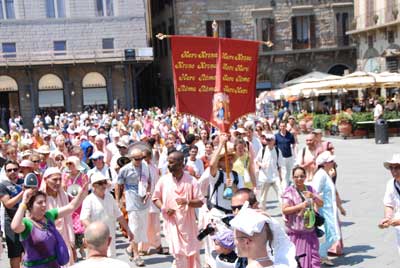 Florence: International harinama sankirtana party On Saturday morning over five-hundred devotees left the festival site with a shopping cart full of books, for a three-hour non-stop kirtana in the heart of Florence. Thousands of locals and tourists enjoyed the spirit, and many partook by filming and photographing the devotees in their bliss. Devotees had many beautiful conversations sharing the glories of Radha and Krsna, and the "Journey of the Soul" was especially very well received. Even a street artist in the middle of his own work was inspired. Within five minutes of receiving a book, he began painting Sri Caitanya Mahaprabhu.
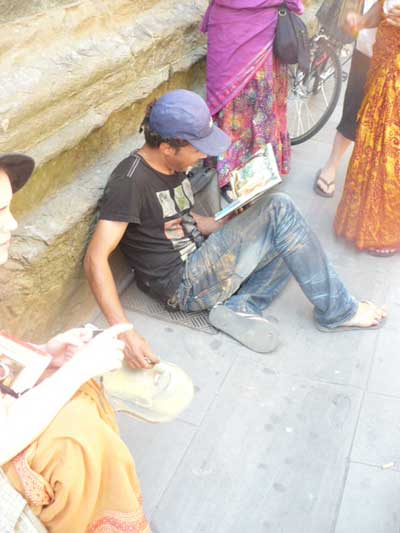 He had been drawing anything and everything on the ground. After receiving a "Journey of the Soul," he began drawing the divine head of Sri Caitanya Mahaprabhu. 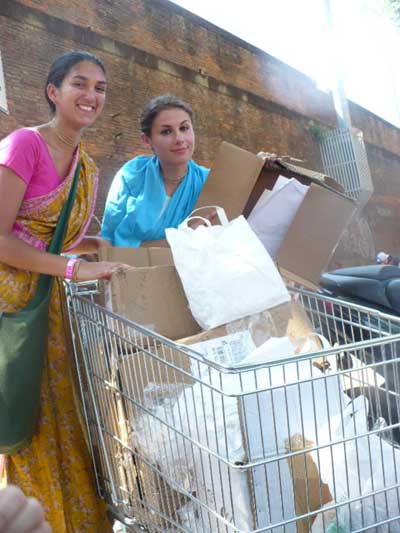 Happy book distribution coordinators: No books left. Srila Maharaja continued harikatha of the Srimad-Bhagavatam with the histories of other devotees who are excellent examples for all to follow, and on one night he revealed the history of the five-year-old child-saint Sri Prahlada Maharaja. To the amazement of the audience, Sripad Damodara Maharaja, Sripad Srauti Maharaja and Sripad Ashram Maharaja enacted the history, which ended with the Lord as Nrsimhadeva ripping apart with His nails the wasp-like demon, Prahlada's father, Hiranyakasipu. The joy and anticipation of the audience became increasingly heightened as Srila Maharaja began to reveal through his own lips and the words of his representative speakers, Sri Krsna's baby and childhood pastimes in Srimad-Bhagavatam's Tenth Canto. These pastimes included baby Krsna killing and liberating the wicked witch Putana. Krsna stealing butter and yoghurt from the neighbors' homes, Mother Yasoda binding child Krsna to a grinding mortar, Krsna delivering the twin Arjuna trees and enlivening the fruit seller, Krsna killing the Bakasura and Aghasura demons, Krsna's punishment of the serpent Kaliya, and Krsna bewildering lord Brahma. Many devotees knew these histories and others, especially the guests, felt themselves just at the beginning of connecting with the depth that comprises Gaudiya Vaisnava philosophy. While the individual speakers' voices resounded over the loud speaker system and Srila Maharaja sat silently to hear, the audience was receiving the real harikatha, which was emanating from the pores of Srila Maharaja's transcendental body in the form of "prema-atoms." 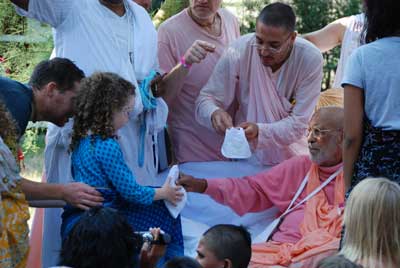 Giving chanting beads and beadbags to the thrilled new initiates Srila Maharaja performed harinama and brahminical initiations in the garden of his quarters, wherein over one hundred aspiring devotees received initiation into a new life of devotion and freedom from the dungeon of dull matter. 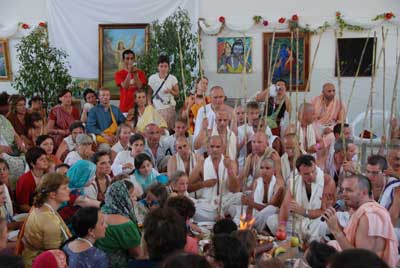 The after-initiation fire sacrifice, led by Sripad Damodara Maharaja
Srila Maharaja and his entourage walked every morning on the pier across from the festival site. He stopped walking and sat down each day for questions and answers, and the audio files of those questions and answers can be heard on www.purebhakti.tv. 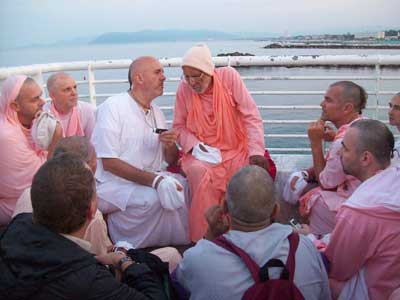 Questions-and-answer period during the morning walk The following is an excerpt from Srila Maharaja's morning walk of July 2nd: Devotee: Guru is one. He is everywhere, omniscient, and omnipresent. Srila Narayana Gosvami Maharaja: If they are in the line of Nityananda Prabhu, then they have those qualities. Different gurus are in different categories; it is not that all gurus are equally qualified, even if they perform the actions of guru or play the role of guru. Those who are not qualified should not play that role. If they are following Nityananda Prabhu, who is akhanda-guru-tattva (the complete, undivided principle of guru) then they are bona fide; then they are guru – according to their level (some may be at any of the three stages of uttama, and others at the top stage of madhyama). Sripad Asrama Maharaja: "Caksu-dana dilo yei – you are my lord, birth after birth." In what stage does the devotee have to be in order to have a specific manifestation of guru-tattva (the same guru) come back to him for a relationship birth after birth? Srila Narayana Gosvami Maharaja: There is no certainty that it will be the same guru. But Nityananda Prabhu is akhanda-guru-tattva, so the bona fide guru, who is in His line, will come. Regarding those bona fide gurus, we should think that "He is in the line of Nityananda Prabhu." Ramanatha dasa: I read in an article in the Harmonist that a pure rasika devotee doesn't worship Nityananda Prabhu as akhanda-guru-tattva, but rather he worships Radharani as akhanda-guru-tattva. Srila Narayana Gosvami Maharaja: No, no, no, no. This is not right. Sripad Madhava Maharaja: Do you have that Harmonist with you? Ramanatha dasa: No, but I think it is an article by Srila Bhaktisiddhanta Sarasvati Thakura. Sripad Madhava Maharaja: Can you show me? Then I can explain. Sripad Asrama Maharaja: I think the point of the article is that one cannot achieve the mercy of Radha-Krsna without the mercy of Nityananda Prabhu. One has to go through Nityananda Prabhu. Sripad Madhava Maharaja: Yes, that is okay. Hena Nitai vinai bhai, Radha-Krsna paite nai. Sripad Asrama Maharaja: Although Nityananda as Balarama is not present in the pastimes of Radha and Krsna, still, without His mercy one cannot attain Their mercy. Srila Narayana Gosvami Maharaja: You should know that as Sri Caitanya Mahaprabhu is Krsna, in the same way Sri Nityananda Prabhu is Baladeva. Baladeva can appear in all forms, and thus He can serve in all rasas; so He manifests as Ananga-manjari, and thus we can worship Nityananda Prabhu in the form of Ananga-manjari. Do you understand or not? [For the purpose of participating in service to Radha-Krsna's conjugal pastimes, Balarama takes the form of Srimati Radhika's younger sister, Ananga Manjari. -ed] (Srila Maharaja then had Sripad Nemi Maharaja and Sripad Asrama Maharaja repeat his statements in their own words.) Sripad Sadhu Maharaja: Many devotees worship Sri Gaura-Nityananda Prabhu. Is it possible to achieve the same result in worshipping Nityananda Prabhu as Ananga-manjari and Sri Caitanya Mahaprabhu as Radha-Krsna – as when worshipping Deities of Sri Sri Radha-Vinodabihari? Srila Narayana Gosvami Maharaja: This is okay. They can think, "I am worshipping Nityananda, but in His form as Ananga-manjari." Sripad Damodara Maharaja: Gurudeva, who is chaya-suka ("shadow-Suka")? Srila Narayana Gosvami Maharaja: Someone says that chaya-suka is Bilvamangala Thakura, and someone else says that chaya-suka was a separate person. Sripad Damodara Maharaja: What do you say? Srila Narayana Gosvami Maharaja: Both are right. Sripad Damodara Maharaja: There is one footnote in the English edition of Beyond Nirvana that when Sukadeva Gosvami went to the forest, he made a shadow form of himself that went back to be with Vyasadeva. Sripad Madhava Maharaja: I have never seen this reference in the Bengali edition. Brajanath dasa: Bhudara and Navadvipa prabhus worked on this book, so perhaps they can explain. Balarama dasa: At what stage does our siddha-svarupa (internally contemplated spiritual form) manifest? Srila Narayana Gosvami Maharaja: At the time of bhava. Kanhaya-lal dasa (from Germany): Srila Gurudeva, it is very easy for devotees who are not very advanced to commit aparadha (offences), and then advancement is not possible. What is the best way to stay free from aparadha? Srila Narayana Gosvami Maharaja: Each person must personally be alert not to commit aparadha. Otherwise, what can you do for him? If that person insists, "I must do it!" then what can I do? It depends on that person. He should always be alert in this regard. Sripad Giri Maharaja: Yesterday Asrama Maharaja explained this verse in his class: nehabhikrama-naso 'sti In this endeavor there is no loss or diminution, and a little advancement on this path can protect one from the most dangerous type of fear." (Bhagavad-gita, 2.40) What kind of fear does this refer to? Srila Narayana Gosvami Maharaja: Here, Krsna has told about bhakti in the madhyama stage. If one is not doing anything wrong – committing no aparadha – then he will gradually develop in his bhakti. But if... yadi vaisnava-aparadha uthe hati mata "If the devotee commits an offense at the feet of a Vaisnava while cultivating the creeper of devotional service in the material world, his offense is compared to a mad elephant that uproots the creeper and breaks it. In this way the leaves of the creeper are dried up." (Sri Caitanya-caritamrta) So we should be alert. The End http://backtobhakti.com/ |
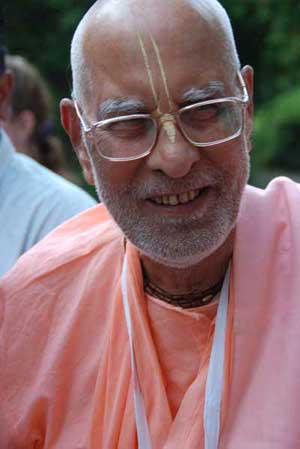
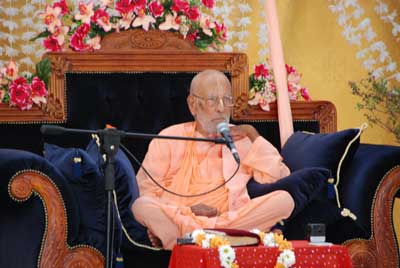


Nenhum comentário:
Postar um comentário